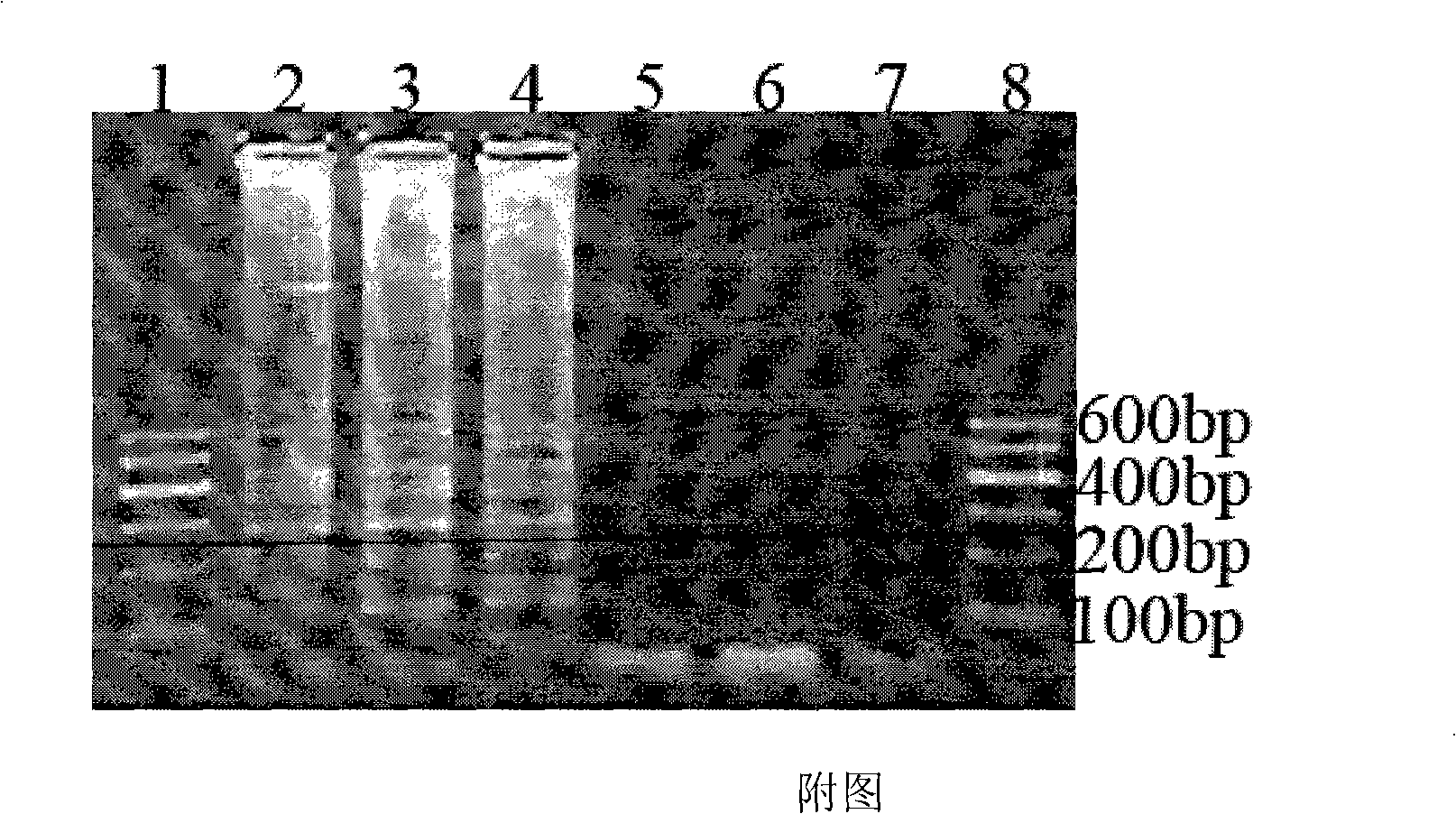Reagent kit for detecting vibrio vulnificus by loop-mediated isothermal amplification technology
A loop-mediated isothermal, vibrio vulnificus technology, applied in the field of pathogen diagnosis, can solve problems such as detection errors, achieve the effects of convenient operation, strong specificity, and avoid repeated cultivation
- Summary
- Abstract
- Description
- Claims
- Application Information
AI Technical Summary
Problems solved by technology
Method used
Image
Examples
Embodiment 1
[0040] Embodiment 1: seawater sample 1
[0041] 1. DNA extraction
[0042] Pick suspected colonies isolated from seawater and add them to 0.4mLTE buffer (pH8.0) for shaking and mixing. Add 40 μL of sodium dodecylsulfonate (10%), and then add 10 μL of proteinase K solution and incubate at 55° C. for 1-2 hours. Add the same volume of Tris-saturated phenol (pH 8.0), shake vigorously, centrifuge at 8000 rpm for 3 minutes, take the supernatant, and repeat the phenol extraction. Take the supernatant, add 0.1 times the volume of sodium acetate (3mol / L), mix well, add an equal volume of ice ethanol, mix well, let stand at low temperature for 30 minutes, centrifuge at 12000 rpm for 5 minutes, discard the supernatant, Wash once with 70% cold ethanol, centrifuge at 12,000 rpm for 5 minutes at room temperature, discard the supernatant, add 50 μL TE solution, and store at -20°C.
[0043] 2) Loop-mediated isothermal amplification (LAMP)
[0044] Add the following reagents to the amplifi...
Embodiment 2
[0066] Embodiment 2: clinical isolate sample 1
[0067] 1. DNA extraction
[0068] Pick the colonies and add them to 0.4mL TE buffer (pH8.0) for shaking and mixing. Add 40 μL of sodium dodecylsulfonate (10%), and then add 10 μL of proteinase K solution and incubate at 55° C. for 1-2 hours. Add the same volume of Tris-saturated phenol (pH 8.0), shake vigorously, centrifuge at 8000 rpm for 3 minutes, take the supernatant, and repeat the phenol extraction. Take the supernatant, add 0.1 times the volume of sodium acetate (3mol / L), mix well, add an equal volume of ice ethanol, mix well, let stand at low temperature for 30 minutes, centrifuge at 12000 rpm for 5 minutes, discard the supernatant, Wash once with 70% cold ethanol, centrifuge at 12,000 rpm for 5 minutes at room temperature, discard the supernatant, add 50 μL LTE solution, and store at -20°C.
[0069] 2) Loop-mediated isothermal amplification (LAMP)
[0070] Add the following reagents to the PCR reagent tube to make a...
Embodiment 3
[0084] Embodiment 3: clinical sample 2
[0085] 1. DNA extraction
[0086] Pick suspected colonies and add them to 0.4mL TE buffer (pH8.0) for shaking and mixing. Add 40 μL of sodium dodecylsulfonate (10%), and then add 10 μL of proteinase K solution and incubate at 55° C. for 1-2 hours. Add the same volume of Tris-saturated phenol (pH 8.0), shake vigorously, centrifuge at 8000 rpm for 3 minutes, take the supernatant, and repeat the phenol extraction. Take the supernatant, add 0.1 times the volume of sodium acetate (3mol / L), mix well, add an equal volume of ice ethanol, mix well, let stand at low temperature for 30 minutes, centrifuge at 12000 rpm for 5 minutes, discard the supernatant, Wash once with 70% cold ethanol, centrifuge at 12,000 rpm for 5 minutes at room temperature, discard the supernatant, add 50 μL LTE solution, and store at -20°C.
[0087] 2) Loop-mediated isothermal amplification (LAMP)
[0088] Add the following reagents to the PCR reagent tube to make a t...
PUM
 Login to View More
Login to View More Abstract
Description
Claims
Application Information
 Login to View More
Login to View More - R&D
- Intellectual Property
- Life Sciences
- Materials
- Tech Scout
- Unparalleled Data Quality
- Higher Quality Content
- 60% Fewer Hallucinations
Browse by: Latest US Patents, China's latest patents, Technical Efficacy Thesaurus, Application Domain, Technology Topic, Popular Technical Reports.
© 2025 PatSnap. All rights reserved.Legal|Privacy policy|Modern Slavery Act Transparency Statement|Sitemap|About US| Contact US: help@patsnap.com

